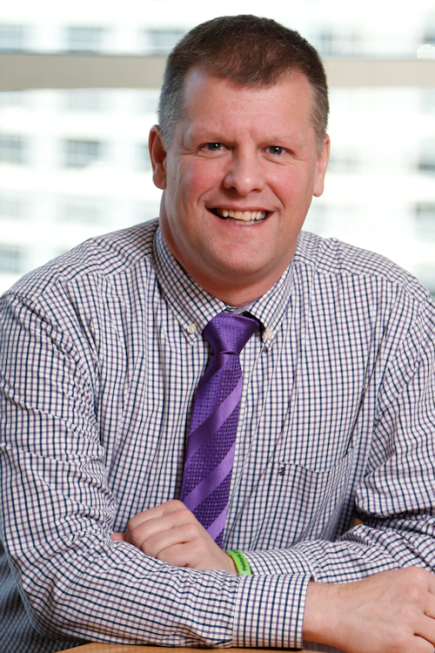
CooperVision recently had an opportunity to sit down with Dr. Jeff Walline to talk about kids and contact lenses.
Jeffrey J. Walline, OD, PhD is the Associate Dean for Research at The Ohio State University College of Optometry. He received his Doctor of Optometry degree from the University of California, Berkeley School of Optometry, and he received his Master’s and PhD degrees from The Ohio State University College of Optometry. Dr. Walline has led several pediatric contact lens studies, and he is the Study Chair of the Bifocal Lenses In Nearsighted Kids (BLINK) Study, a National Eye Institute-sponsored randomized clinical trial to investigate the myopia control effects of soft multifocal contact lenses.
To get us started, can you can give our readers an overview of your background and your current areas of research at The Ohio State University.
Sure. I received my optometry degree from the UC Berkeley School of Optometry and then came to The Ohio State University College of Optometry and earned my PhD. My PhD work involved myopia control with gas permeable contact lenses, and from there, I did industry sponsored research on fitting kids with contact lenses. Since then, I have conducted several myopia control studies involving orthokeratology contact lenses and now soft multifocal contact lenses. In fact, we just completed a soft multifocal contact lens study spanning three years of follow up with 294 kids last week. We do not have results yet, but they are coming in the not too distant future.
What do you think is the right age for children to begin wearing contact lenses? What do you base that belief on?
I actually do not believe that there is an age at which children should start wearing contact lenses. Some of us know four-year olds who are capable of independent contact lens wear, and we all know 25-year olds who are not capable of contact lens wear.
I usually tell people to think about the three factors, that is maturity, the parents, and motivation. A mature child will take care of their contact lenses. A motivated child will be relatively easy to fit with contact lenses. A parent is very important, because they bring the child to the contact lens visits and help the child take care of the lenses when necessary. We want a caring but not overbearing parent, because overbearing parents do not allow their children to ever independently be able to care for their contact lenses. This information is based on experience fitting a lot of kids with nearly all types of contact lenses, from daily disposable to orthokeratology and gas permeable contact lenses.
You spoke about fitting children successfully in a variety of contact lens types.
Within soft contact lenses, do you feel like there is a preferred modality of wear for children, between daily disposable and frequent replacement?
I think basically all patients should be fit in daily disposable contact lenses if they are available, and if they are affordable for the particular patient.
You have been heavily involved in research of children in contact lenses.
What was the biggest surprise for you from the research findings that have come out of these various studies?
For me, the biggest surprise was the results of the ACHIEVE[1] Study, which showed that kids benefitted in terms of their self-perceptions just based solely on contact lens wear. We worked closely with a pediatric psychologist who said, even interventions that are aimed at improving self-perceptions in young children are rarely able to do so, at least not on a very large scale. He was astounded by the fact that simply fitting kids with contact lenses had a fairly profound effect on their self-perceptions, especially in the areas of physical appearance, social acceptance, and also athletic competence.
What do you think are the most broadly held myths by ECPs about children and contact lenses?
We actually took a look at what we thought might keep practitioners from fitting kids with contact lenses. For example, we thought they might think that risk to benefit ratio is worse for children than it is for teenagers. What we found was that the risk to benefit ratio is exactly the same in children as it is in teenagers.2 We also thought that they might believe that it takes more time to fit children than teenagers with contact lenses. We found that the median difference is only five minutes greater for children than it is for teenagers. Basically, what that tells us, there are a few more children who require additional time, but the vast majority of children and teenagers take about the same amount of time.[2] We think we have actually answered all of the questions that we can think of at least that practitioners might have with regard to fitting kids with contact lenses. The only thing that was outstanding that I think we have also answered is, ”What are the long-term issues that might be associated with fitting kids at younger ages?” We actually did a retrospective study where we only looked at people who had worn soft contact lenses for at least 10 years and compared those fittest children versus those fit as teenagers. We found that there were not additional harms to those fit at younger ages. We truly believe that we have answered all the questions. I think those practitioners who are not fitting children just have some personal belief, and they do not allow evidence-based optometry to tell them anything different. I do not think that they are treating their patients optimally, especially if they are not at least providing contact lenses as an option.
[1] Optom Vis Sci. 2009 Mar;86(3):222-32. doi: 10.1097/OPX.0b013e3181971985.
[2] Optom Vis Sci. 2007 Sep;84(9):896-902.







